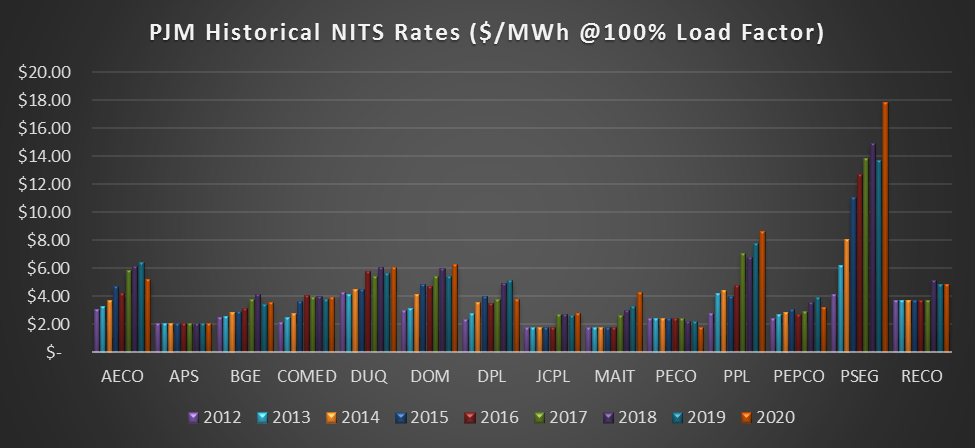Understanding Transmission Costs in Your Power Bill
4 min readIn addition to energy supply cost, retail electricity prices can include many other components such as transmission, ancillary service, capacity and renewable portfolio standards costs. What are these various components, their rates and what does it means to customers of competitive energy suppliers? Below are some answers to frequently asked questions that are commonly received about electricity transmission rates.
What is transmission?
Transmission is the bulk transfer of electrical energy from generating power plants to electrical substations located near demand centers. The U.S. electric transmission grid consists of more than 200,000 miles of extra high-voltage transmission lines (230 kilovolts and greater). Electricity travels at nearly the speed of light, arriving at a destination at almost the same moment it is produced. Transmission lines, when interconnected with each other, become transmission networks, typically referred to as “power grids” or simply “the grid.”
Transmission is distinct from power distribution, which is the local wiring between high-voltage substations and customers. Transmission infrastructure may be owned, operated and maintained by electric utilities or independent transmission owners.
What are transmission rates, and how are they set?
In PJM, the main transmission rate is Network Integration Transmission Service or NITS. NITS is the mechanism by which transmission owners recover their annual transmission costs and revenue requirements from PJM network customers. Transmission owners set their rates using either a fixed/stated NITS rate to recover their costs or a forward-looking formula-based rate, which is a projection of their revenue requirement for the upcoming operating year. Formula rates are only set for one year, and depending on the utility, are updated in either January or June.
A second transmission-related cost in PJM is the Transmission Enhancement Charge. In PJM’s Regional Transmission Enhancement Plan (RTEP), PJM “identifies transmission system upgrades and enhancements to provide for the operational, economic, and reliability requirements of PJM customers.” The Transmission Enhancement charge compensates the transmission owners responsible for developing these projects. The costs of these projects are allocated across the zones based on a net benefit analysis by PJM. These charges can result in a credit if the transmission owner includes these costs in their NITS rates such as with PSEG.
Changes to the transmission rates are submitted to the Federal Energy Regulatory Commission (FERC) and charged to a customer’s retail supplier by PJM or to the utility if they are responsible for collecting those charges. In MD, NJ, DC, DE and IL, the retail supplier is responsible for collecting both charges while in Ohio, the utilities are responsible for collecting them. In Pennsylvania, First Energy utilities (METED, PENELEC, West Penn Power, Penn Power) and PECO collect Transmission Enhancement Charges and the retail supplier collects NITS.
What have historical NITS rates been?
Over the past years, NITS rates have been increasing across the PJM footprint as transmission owners invest in system upgrades and enhancements due to reasons such as aging infrastructure, generation retirements, new gas and renewable generation, and changes in demand. The chart below depicts the historical NITS rates across most of the PJM zones starting in 2012.
How is my transmission rate calculated?
NITS and Transmission Enhancement Charges are demand-based charges based on a customer’s Network Service Peak Load value, which is also known as the transmission tag or transmission PLC. They are calculated using the following formula:
(NSPL x Transmission Rate $/MW-day x # of Days in term)/Forecast Term Volume
Can I see transmission rates on my bill?
How transmission rates are incorporated into electricity bills varies based on electric distribution company, supplier and the electricity product.
Should I lock in my transmission rates?
The answer to this question greatly depends on your business’ budget and risk tolerance. Customers that value budget certainty may select a product that locks in these component costs, while customers that want flexibility in managing them can choose to “pass through” these costs. Hybrid options to managing these costs include a “price adjust” product and a “cost adjust” product. The price adjust product allows customers to lock in a rate based on their NSPL value and the current PJM posted transmission rates but any future transmission rate changes, up or down, will be passed through to the customer on their invoice. The cost adjust product allows customers to lock in a rate based on their NSPL value and current PJM posted transmission rate but any future transmission rate changes, up or down, and any future NSPL value changes, up or down, will be passed through to the customer on their invoice.
Do I have options to fix or pass through transmission rates in non-competitive markets?
No. Only competitive retail energy markets offer the many options that allow for more insight and better management of energy costs for businesses and government agencies. Customers of competitive energy suppliers like Constellation can choose from a wide array of products to meet their business goals and their approach to budget, risk and cost management. From fixed-price options that lock in rates for budget certainty to index-based and block options that allow for more flexibility and customization, energy end users can select products that bring value.
To stay up to date on the latest changes in the market that may affect your energy bill, please subscribe to receive our blog updates in your inbox at constellation.com/subscribe.

